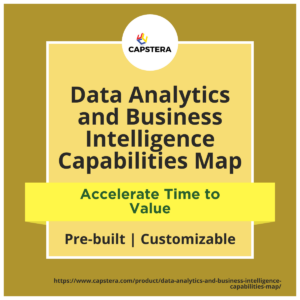
The following is a whitepaper that provides a comprehensive overview of business architecture-enabled business intelligence transformation, including the specific components of business architecture and how to leverage them in transformation planning and execution.
Summary of Business Architecture-enabled Business Intelligence Transformation
As we step into a digitally driven business world, reflecting on the evolution and upcoming transformation of the Business Intelligence (BI) function is essential. Historically, Business Intelligence began to present business information through basic charts and graphs. It was a tool for descriptive analytics, condensing vast amounts of data into manageable, digestible visuals. Over time, as businesses recognized the competitive advantage of data, BI evolved, adopting more predictive and prescriptive capabilities. This development signaled a paradigm shift for BI, transitioning from simply providing simplistic data representations to being a key player in strategic, data-driven decision-making.
In our present-day digital age, a significant transformation of the Business Intelligence function has become a strategic advantage and an urgent necessity. The impetus for this urgency arises from the rapid proliferation of data sources, the complexity of data, and the growing need to extract actionable insights promptly. Companies must use advanced BI capabilities to maintain competitiveness and survive in a data-saturated environment. To fail to do so could mean getting left behind.
This is where the role of business architecture becomes pivotal. As a structural blueprint of the organization, business architecture provides a comprehensive view of the business strategy, processes, information, and technology assets. It supports BI transformation by aligning it with the business’s overarching strategies and goals, ensuring the efficient use of resources, and identifying potential synergies.
Business architecture guides the BI transformation by defining key aspects such as the transformation’s scope, objectives, and methods. It aids in the translation of the overall corporate strategy into specific, executable plans. It further ensures that these plans align with the organization’s unique needs, capabilities, and constraints.
The imperative to transform BI for the digital age is undeniable. Business architecture is a strategic compass and an operational map, charting the path toward a successful, impactful transformation. Organizations can navigate the complex BI transformation journey by leveraging business architecture with clarity, coherence, and conviction.
Setting the Stage for Business Architecture-enabled Business Intelligence Transformation
 As we journey into the data and digital transformation age, the role of Business Intelligence (BI) continues to evolve, gaining strategic significance in the process. Historically, Business Intelligence was predominantly a support function, largely confined to generating basic charts and graphs that presented historical data in a more comprehensible format. These rudimentary visuals allowed businesses to understand what had happened but offered little guidance on what to do next or what the future might hold.
As we journey into the data and digital transformation age, the role of Business Intelligence (BI) continues to evolve, gaining strategic significance in the process. Historically, Business Intelligence was predominantly a support function, largely confined to generating basic charts and graphs that presented historical data in a more comprehensible format. These rudimentary visuals allowed businesses to understand what had happened but offered little guidance on what to do next or what the future might hold.
However, in recent years, the role of Business Intelligence has undergone a paradigm shift. BI no longer simply illustrates past performance; it now harnesses a multitude of data to enable future-looking, data-driven strategic decisions. This shift elevates the role of BI from a back-office function to a core strategic one, placing it at the center of decision-making. Businesses now leverage BI to identify trends, predict outcomes, prescribe actions, and ultimately drive strategic initiatives. Thus, BI has evolved as the foundation for a data-driven culture promoting evidence-based decision-making and strategic thinking.
The advent of digital transformation has further catalyzed this evolution, particularly affecting Data Analytics and Business Intelligence functions. Digital transformation, with its emphasis on digitizing processes, leveraging technology, and cultivating a digital culture, has amplified the value of data and the need for sophisticated analytical tools. The proliferation of digital data sources has enriched the data landscape, creating a wealth of opportunities for businesses to gain insights, enhance performance, and drive innovation.
Simultaneously, digital transformation has introduced more advanced and diverse BI tools, such as machine learning and artificial intelligence, capable of handling vast and complex datasets. These tools have not only improved the speed and efficiency of data processing but have also enabled more sophisticated analytics, such as predictive and prescriptive analytics.
The impact of digital transformation on BI and Data Analytics is profound. It has compelled these functions to become more agile, flexible, and adaptive. It has urged them to embrace innovation and constantly learn and evolve. In the face of digital transformation, BI and Data Analytics functions are no longer mere spectators; they are now active participants and drivers of the transformation journey. In conclusion, the evolving role of BI, driven by the paradigm shift and digital transformation, underscores the strategic significance of this function in the current business landscape.
The Imperative for Business Architecture-enabled Business Intelligence Transformation
In the rapidly evolving business and market landscape, the role of Business Intelligence (BI) has never been more crucial. With an accelerating digital revolution, the explosion of data sources, and the rise of customer-centric business models, the business environment has become increasingly complex and competitive. Amidst these changes, BI plays a pivotal role in driving strategic decision-making, identifying growth opportunities, and enabling competitive differentiation.
Business Intelligence, however, must keep pace with these external changes. Advancements in technology have led to the emergence of new types of data, more sophisticated analytics techniques, and a plethora of BI tools and platforms. Moreover, changing business models, driven by factors like globalization, digitalization, and changing customer expectations, necessitate more dynamic, adaptive, and forward-looking BI capabilities. Staying static in this dynamic environment is not an option. BI needs to transform in order to seize the opportunities and confront the challenges that this new landscape presents.
The transformation of Business Intelligence is not a mere upgrade; it’s a fundamental shift in how businesses leverage data to drive decisions and value. It involves moving away from traditional, siloed, and reactive BI practices to more integrated, proactive, and strategic ones. It means adopting advanced analytics, artificial intelligence, and machine learning to predict future trends, prescribe optimal actions, and automate decision-making. It involves cultivating a data-driven culture encouraging curiosity, experimentation, and learning.
The benefits of a successful Business Intelligence transformation are manifold. First and foremost, it can enhance decision-making by providing more accurate, timely, and actionable insights. It can enable businesses to anticipate market trends, understand customer needs, optimize operations, and innovate products and services. It can boost efficiency by automating data processing and analysis, reducing errors, and saving time. It can increase competitiveness by providing a deeper understanding of the market, competitors, and internal performance.
Moreover, a transformed BI function can foster a more agile and resilient business. Providing real-time insights allows businesses to respond to changes and disruptions quickly. Offering predictive and prescriptive analytics, it equips businesses to manage risks and seize opportunities proactively. Lastly, a transformed BI can empower all employees to make data-driven decisions by democratizing data and analytics, fostering innovation and collaboration across the organization.
The imperative for Business Intelligence transformation is clear and compelling. In a fast-paced, data-rich, and dynamic business environment, transforming BI is not just beneficial but necessary for survival and success. With its numerous benefits and strategic significance, BI transformation should be a top priority for businesses aspiring to thrive in the digital age.
Foundations of Business Architecture-enabled Business Intelligence Transformation
Business architecture serves as the blueprint of a business, outlining its structure and intricacies. It provides a holistic view of the organization’s strategy, processes, information, technology, and resources. Business architecture is essentially a conceptual framework that allows organizations to understand the relationships between their business functions, strategy, and the desired outcomes. It plays a critical role in the planning, designing, and implementing strategic initiatives, serving as a bridge between strategy and execution.
In the context of strategic transformations such as Business Intelligence (BI) transformation, the importance of business architecture is significant. It provides a clear roadmap for the transformation, outlining what needs to change, why it needs to change, and how to make the change. It ensures the transformation aligns with the overall business strategy, leverages existing resources effectively, and creates synergies between different functions. By offering a comprehensive and integrated view of the business, business architecture helps identify potential obstacles, risks, and opportunities for transformation, enabling proactive planning and management.
Business architecture has proven instrumental in facilitating transformations in various business functions. For instance, in IT transformations, business architecture has helped align IT investments with business goals, streamline IT processes, and enhance IT service delivery. In supply chain transformations, it has helped optimize supply chain operations, improve supplier relationships, and enhance customer service. Similarly, in human resources transformations, business architecture has aided in redefining job roles, redesigning HR processes, and enhancing employee engagement and performance.
Business architecture doesn’t function in isolation when embarking on a Business Intelligence transformation. It collaborates closely with other architectural domains to ensure a holistic, integrated, and effective transformation. It works hand in hand with enterprise architecture to align the BI transformation with the broader enterprise vision and strategy. It coordinates with data architecture to ensure the transformed BI function can effectively manage, process, and leverage data. It collaborates with technical architecture to ensure the appropriate use of technology in the BI function. It aligns with solution architecture to design and implement effective BI solutions. Lastly, it works alongside security architecture to ensure that the transformed BI function adheres to data privacy, security, and compliance standards.
Business architecture plays a pivotal role in guiding and enabling Business Intelligence transformation. Providing a comprehensive and coherent blueprint ensures that the transformation is strategic, integrated, effective, and value-creating. Collaborating with other architectural domains ensures that the transformation is holistic, secure, and sustainable. Therefore, for businesses planning a BI transformation, leveraging business architecture is not just beneficial but crucial.
Components of Business Architecture for Business Intelligence Transformation
 In the context of Business Intelligence (BI) transformation, various business architecture components facilitate an effective and holistic change. These components help clearly define the transformation journey, ensure alignment with business goals, and execute the transformation strategy.
In the context of Business Intelligence (BI) transformation, various business architecture components facilitate an effective and holistic change. These components help clearly define the transformation journey, ensure alignment with business goals, and execute the transformation strategy.
Strategy Elaboration and Translation: The transformation journey begins by clarifying and elaborating the corporate or business strategy. Artifacts such as the Business Model Canvas (BMC), Strategy Maps, and Balanced Scorecards are instrumental in this process. These tools help break down complex strategies into understandable and executable components, connecting strategic objectives with actions and performance metrics. They ensure that the BI transformation aligns with, supports, and advances the business strategy.
Business Capability Maps: These tools define the organization’s current and desired BI and Data Analytics capabilities. Capability maps illustrate how various BI functions align with the organization’s overall strategy, from data gathering to analysis to reporting. By mapping capabilities, organizations can identify gaps, redundancies, and opportunities for improvement, providing a clear direction for the BI transformation.
Value Streams: Value streams help identify the critical business flows for BI and Data Analytics that generate stakeholder value. These flows could be processes, systems, or activities that transform data into insights and actions. By mapping these value streams, organizations can understand how BI contributes to business objectives, customer value, and operational efficiency. This understanding is vital for designing the transformed BI function.
Business Data Models: A comprehensive compilation of BI data and information entities, business data models organize and classify data based on their type, source, use, and relationships. This organization aids in efficiently managing, processing, and utilizing data, serving as a foundation for data governance, data quality, and integration efforts.
Cross-Mapping: Cross-mapping involves establishing the interdependencies and relationships between various entities and data. For instance, Capability-to-Value Stream Mapping shows how specific capabilities enable value streams, while Capability-to-Data Mapping shows how capabilities utilize data. Cross-mapping reveals the footprint of each capability, highlights synergies, and identifies gaps or redundancies, guiding the design and implementation of the BI transformation.
Viewpoints: Viewpoints help organizations gain various perspectives on their business architecture data. They provide insights into aspects such as the strategic importance of a capability vis-a-vis the budget allocated to it, the maturity gap of capabilities from the desired state, and the redundancies and replication in systems or applications. These viewpoints inform decision-making, prioritization, and resource allocation in the BI transformation.
Capability-based Roadmaps: Unlike traditional project execution roadmaps, capability-based roadmaps focus on evolving capabilities. They outline the journey from the current to the desired capabilities, factoring in aspects such as interdependencies, risks, resources, and timelines. These roadmaps guide the phased implementation of the BI transformation, ensuring that the transformation delivers value incrementally and continuously.
In conclusion, the components of business architecture play a vital role in the BI transformation. They provide a comprehensive and coherent framework for planning, designing, and implementing the transformation, ensuring its alignment with business strategy, integration across functions, and effectiveness in delivering value.
Planning the Business Architecture-enabled Business Intelligence Transformation
 Planning is a crucial phase in the Business Intelligence (BI) transformation process. It sets the direction for the transformation, identifies the necessary actions, and prepares the organization for change.
Planning is a crucial phase in the Business Intelligence (BI) transformation process. It sets the direction for the transformation, identifies the necessary actions, and prepares the organization for change.
The components of business architecture play a pivotal role in planning the transformation. Strategy elaboration and translation help define the transformation’s objectives and align it with the business strategy. Business capability maps and value streams guide the design of the transformed BI function. Business data models help plan the transformation’s data management and utilization aspects. Cross-mapping aids in identifying synergies, interdependencies, and gaps, informing the prioritization of actions. Viewpoints provide insights for decision-making, while capability-based roadmaps guide the phased implementation of the transformation. Each component creates a comprehensive, coherent, and actionable transformation plan.
Several key factors need consideration during the planning phase. First, the current state of the BI function: What are its capabilities, strengths, and weaknesses? What data does it manage, and how effectively does it use this data? Second, the desired state of the BI function: What new capabilities does it need to develop? How does it need to manage and use data differently? Third, the gap between the current and desired state: What changes does the BI function need to make? Fourth, the resources needed for the transformation: What investments, skills, and technologies are required? Lastly, the risks associated with the transformation: What potential obstacles, challenges, or setbacks might occur?
The planning phase is not without its challenges. One common challenge is resistance to change from employees who are accustomed to the current BI practices. This resistance can be mitigated by clear communication about the benefits of the transformation, involving employees in the planning process, and providing adequate training and support. Another challenge is the complexity and uncertainty of the transformation. This complexity can be managed by breaking down the transformation into manageable phases, using business architecture to guide the process, and adapting the plan as necessary based on feedback and learnings.
Planning the BI transformation involves leveraging business architecture components, considering key factors, and addressing potential challenges. A well-planned transformation lays the foundation for successful execution and ensures that the transformation delivers the intended value and outcomes.
Executing the Business Architecture-enabled Business Intelligence Transformation
Execution is the stage where planning transitions into tangible action and where the vision for the Business Intelligence (BI) transformation becomes a reality. There are several essential steps to consider when implementing the transformation plan:
- Prioritization and Sequencing of Actions: Begin by organizing and scheduling the actions based on the capability-based roadmap. Prioritize actions that offer significant value or serve as prerequisites for other actions. Remember, the transformation doesn’t need to happen simultaneously—it can proceed in phases, enabling continuous learning and adjustment.
- Resource Allocation and Mobilization: Allocate financial, technological, and human resources to the prioritized actions. Make sure everyone involved knows their roles and responsibilities and has the necessary skills and support.
- Implementation of Actions: Execute the planned actions, whether they involve developing new capabilities, improving data management practices, or implementing new technologies. Regular monitoring and reporting of progress against the plan are vital during this stage.
Change management is another crucial aspect of execution. It’s essential to win employees’ buy-in for the transformation to overcome resistance and drive the adoption of new practices. Frequent and transparent communication about the transformation—its benefits, progress, and impacts—can help build support. Additionally, involve employees in the transformation, seek their input, and acknowledge their contributions to fostering a sense of ownership and commitment.
Training and support are also critical for enabling employees to adapt to new ways of working. Provide training on new capabilities or technologies, offer coaching and mentoring, and create a support structure for handling queries or issues.
Measuring success is integral to the execution phase. Define clear, quantifiable measures of success for the transformation. These might include improvements in data quality, increases in the use of BI for decision-making, or enhancements in the value delivered by BI.
Regularly monitor these measures to assess the progress and effectiveness of the transformation. Don’t hesitate to adjust the plan based on these assessments. If certain actions aren’t delivering the expected results, consider revising the approach or re-prioritizing actions.
Executing the BI transformation involves implementing the transformation plan, managing change, and measuring success. The goal is to execute the plan and ensure that the transformation delivers real value and achieves the organization’s strategic objectives.
Business Architecture-enabled Business Intelligence Transformation: Case Studies
1. Healthcare Provider’s Business Intelligence Transformation
A leading healthcare provider faced significant challenges with its Business Intelligence (BI) function. The BI tools were outdated, there was limited capacity for advanced analytics, and data silos hindered comprehensive analysis.
The organization implemented a BI transformation to address these challenges, guided by business architecture. They started with a detailed Business Capability Map, which helped them identify the current capabilities of their BI function and the new capabilities they needed to develop. Next, they constructed Value Streams to understand the critical business flows and how improved BI could enhance value for their stakeholders.
Using these components, the organization developed a comprehensive transformation plan. The plan involved implementing a new BI platform, consolidating data sources to break down silos, and training staff in data analysis and interpretation.
The outcome of the transformation was striking. The organization now has a robust, modern BI function that supports advanced analytics and provides comprehensive, actionable insights to decision-makers, significantly improving their operational efficiency and patient outcomes.
2. Retailer’s Data Analytics Transformation
A large international retailer was struggling with a lack of actionable insights from their data. Their Data Analytics function was not adequately integrated with the business strategy, resulting in missed opportunities and inefficient operations.
The retailer decided to transform their Data Analytics function using business architecture. They began by translating their business strategy into a Strategy Map and Balanced Scorecard, which clarified the role of data analytics in achieving the strategic objectives. They then developed a Business Capability Map for the Data Analytics function, which helped them understand their current capabilities and align these with the overall business strategy.
Guided by these business architecture components, the retailer implemented a transformation plan. They invested in advanced analytics tools, developed new analytics capabilities, and restructured the Data Analytics function to better align with the business strategy.
The transformation had a significant positive impact. The Data Analytics function now strategically delivers actionable insights that guide decision-making and drive business performance. The retailer has achieved substantial improvements in sales, customer satisfaction, and operational efficiency, demonstrating the transformative power of business architecture.
In both these cases, business architecture provided the necessary framework and guidance for the transformation. It enabled the organizations to understand their current state, define their desired state, plan their transformation effectively, and execute it successfully, thereby reaping substantial benefits.
Finishing Thoughts on Business Architecture-enabled Business Intelligence Transformation
 In today’s digital age, businesses are in an environment marked by intense competition and a growing need for data-driven decision-making. Business Intelligence (BI) has evolved from a basic chart and graph provider to a strategic enterprise enabler, underscoring the critical need for its transformation. It’s no longer a matter of choice, but a strategic imperative, to keep pace with technological advancements and shifting business models.
In today’s digital age, businesses are in an environment marked by intense competition and a growing need for data-driven decision-making. Business Intelligence (BI) has evolved from a basic chart and graph provider to a strategic enterprise enabler, underscoring the critical need for its transformation. It’s no longer a matter of choice, but a strategic imperative, to keep pace with technological advancements and shifting business models.
Business architecture has emerged as a vital guide in this transformation journey. By offering a functional blueprint for the BI transformation, the business architecture enables an organization to translate its strategy into execution. Key components such as Strategy Elaboration, Business Capability Maps, Value Streams, Business Data Models, and Cross-Mapping ensure alignment with the overall business strategy and help identify and bridge gaps.
The case studies of the healthcare provider and the international retailer underline the powerful impact of a well-planned and executed BI transformation guided by business architecture. These transformations significantly improved operations, strategy alignment, and decision-making capabilities.
Looking ahead, the role of BI is only set to grow. As technology evolves and businesses become even more data-driven, BI will become an even more strategic function. As we look to the future, the potential of AI, machine learning, and other advanced technologies promise further opportunities for digital transformation in BI.
The journey of BI transformation may be complex. Still, with a strategic focus, a well-planned approach, and the right guidance from business architecture, businesses can successfully navigate this transformation and harness the power of BI to drive their success.
Recommendations for Business Architecture-enabled Business Intelligence Transformation
The journey toward Business Intelligence (BI) transformation can seem daunting, but the following actionable steps can provide a structured approach for BI leaders and business/technology executives:
- Set Clear Objectives: Begin by defining what you hope to achieve from the BI transformation. These goals should align with your business strategy and may include improving decision-making, enhancing operational efficiency, or driving innovation.
- Understand the Current Landscape: Analyze your current BI capabilities and data analytics functions. This includes the technical infrastructure, skill levels of staff, data quality, and how well your current BI function supports strategic decision-making.
- Leverage Business Architecture: Use business architecture to guide your BI transformation. Key components like Strategy Elaboration, Business Capability Maps, Value Streams, and Business Data Models will help clarify your business strategy, identify your current capabilities, and guide you toward the desired state.
- Plan Your Transformation: Create a detailed transformation plan, considering the identified gaps, required resources, potential challenges, and timeline. The plan should be realistic, flexible, and aligned with the business strategy.
- Ensure Organizational Buy-In: Change is often met with resistance. Encourage buy-in from all levels of the organization by communicating the benefits of the transformation, training staff in new tools and techniques, and involving them in the process.
- Execute and Monitor the Transformation: Implement your plan, monitor progress, and measure success against defined objectives. Be prepared to make adjustments as needed. Remember, BI transformation is a journey, not a one-time project.
- Foster a Data-Driven Culture: To truly leverage the potential of BI, cultivate a data-driven culture where data and analytics are integral to decision-making at all levels.
- Stay Ahead of Technological Advancements: The digital age is constantly changing, especially in technology. Stay abreast of the latest BI tools and techniques, and be ready to adapt as necessary.
Embarking on a BI transformation journey can be a significant undertaking. Still, the rewards can be substantial with a clear vision, meticulous planning, and a commitment to fostering a data-driven culture. Remember, the objective is to implement new tools or processes and transform how your organization uses data to drive decision-making and business success.



